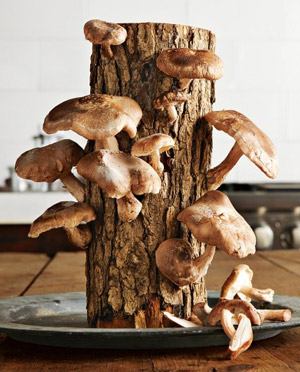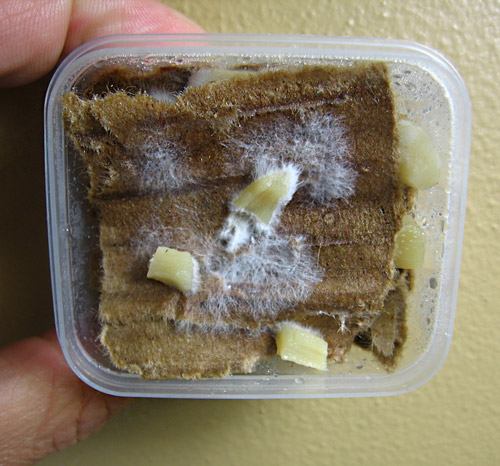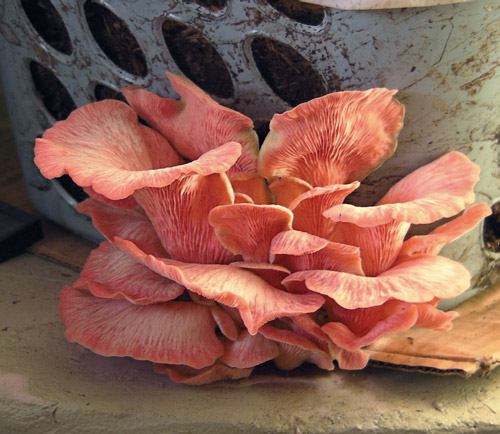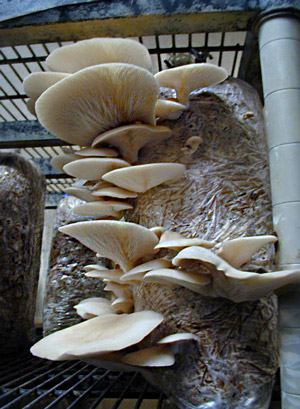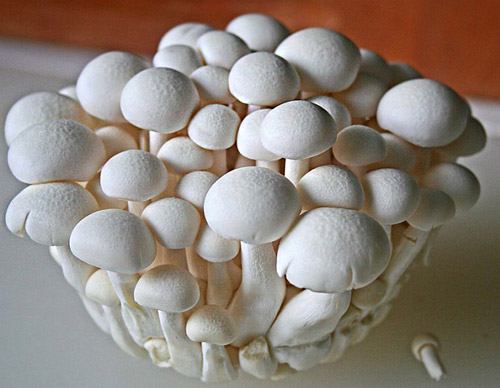Choosing a substrate for growing mushrooms is not that simple. The substrate is the material in which the mushroom will grow. Many materials can serve as substrates. Coffee grounds, tea leaves, straw, stumps and logs, cardboard - you always have a choice.
The substrate is inoculated with mycelium. To learn more about it, check out the article Mycelium for Mushrooms . Let’s focus on the most popular and nutritious substrates for mushroom cultivation, examining their drawbacks and advantages; we’ll figure out which substrate is right for you.
Straw Substrate for Mushrooms
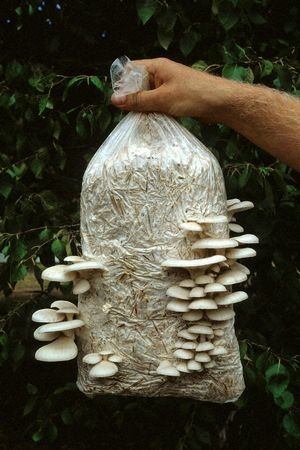 Straw substrate and oyster mushrooms on it.
Straw substrate and oyster mushrooms on it.
Wheat, rye, oat straw is a good nutrient base for mushroom growth. Moreover, it is very cheap and always available. For information on how to grow mushrooms on straw, read Growing Mushrooms on Straw . Straw is particularly attractive due to its versatility, as it is suitable for growing most types of mushrooms. Its nutrient fibers are easily broken down and absorbed by the mushroom.
The downside of straw is that it needs to be sterilized (pasteurized). Straw is inherently contaminated with other, more aggressive fungi and mold spores that compete with our mycelium for nutrients. For more details on straw disinfection, read this article .
Mushrooms on Logs
Mushrooms on logs are the most delicious, so I’ll discuss logs in great detail. The colonization of mushrooms in wood occurs rather slowly but very successfully. Deciduous tree species are suitable for mushroom cultivation; however, avoid white acacia and black walnut. Maple, poplar, willow, birch, chestnut, ash, fruit trees - all these are good choices. The denser and heavier the wood, the longer it will take for mycelium colonization and mushroom growth.
The trees you use should be healthy and free from signs of other fungi. Lichens or moss are allowed but should be cleaned off the log. The ideal time for cutting is late February to mid-March, when the tree’s sap begins to flow. It is preferable to do this before new foliage appears. If you inoculate such a young, living log with mycelium, the mushrooms will have an abundance of food.
Log length can range from 50 cm to 1.5 meters, and the diameter should be about 10-15 cm. Logs of larger diameter can be used, but this will take more time for colonization. Thinner logs are prone to breaking. Freshly cut logs should not be inoculated immediately; they need to rest for two weeks to six months. The storage place for logs should be clean and ventilated, and they should not touch the ground. During research for the article, I came across a single recommendation that logs should be soaked for 24 hours. This recommendation was for dry logs, but I lean towards not using dry old logs, especially if you are growing mushrooms for the first time. Do not store logs for more than six months, as other, inedible fungi will settle on them. Logs are the best substrate for growing mushrooms.
The best time for inoculating mushrooms is spring when frosts are less severe. If your logs are on a glazed balcony, you don’t need to worry about frost. Starting cultivation in hot weather is not ideal—generally, avoid extreme temperatures.
What you’ll need:
Deciduous logs.
Drill and 5/16 inch wood bit.
Workbench or any other surface for work (or an assistant).
Hammer, preferably rubber.
Natural wax (I haven’t seen recommendations for using paraffin).
Brush for applying wax (paintbrush, small).
Mushroom plugs (dowels).
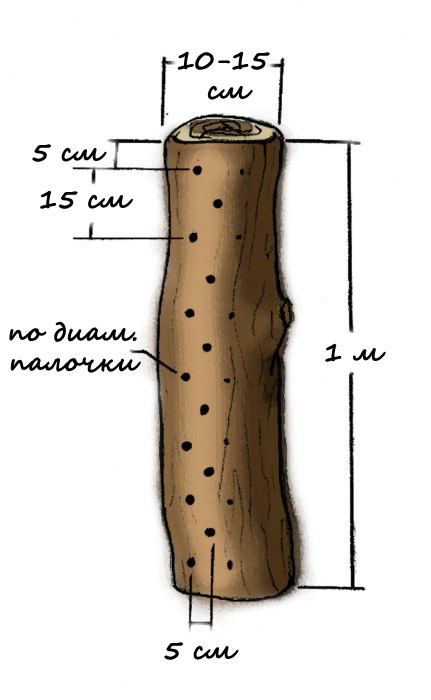 How to prepare a log for mushroom cultivation. Drilling scheme.
How to prepare a log for mushroom cultivation. Drilling scheme.
The picture shows how to drill holes for mushroom plugs. The depth and size depend directly on the size of the mushroom dowel. Do not drill too deep—this leaves a dry air pocket under the dowel. Once all holes are ready, carefully insert the dowels. Try not to damage the bark.
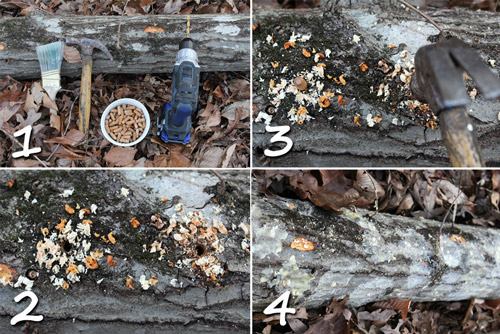 Photo-guide to growing mushrooms on logs
Photo-guide to growing mushrooms on logs
 A year later, Shiitake mushroom
A year later, Shiitake mushroom
Once all the dowels are in place, melt the wax in a double boiler and carefully seal the “mushroom spots” and the cut end of the log. This will provide insulation, prevent moisture loss, and protect against insects and microparasites. The wax should be really hot; otherwise, it will dry out quickly and peel off as its molecules won’t penetrate deeply enough to adhere to the wood fibers.
The next stage is the most important—log colonization with mycelium. This process is very slow—ranging from six months to a year and a half (statistically, but it can be sooner). During this time, humidity is crucial. If you plan to conduct this mushroom adventure inside (on a loggia, balcony), maintaining humidity for the logs will be
both easier and more challenging. Several logs can be placed on a support and placed in a water-filled tray. Direct sunlight is not recommended. To protect the logs from direct light, you can cover them with hygroscopic tarpaulin. Water the logs every 2 weeks if the air temperature is around 22-25 degrees Celsius, or more frequently if it is hot and dry—intuition will guide you. Of course, growing mushrooms on logs indoors is an experiment for the most daring adventurers))).
If your logs are outside, ensure they are in shade and moderate warmth, with high humidity. Logs should not touch the ground. The ideal place is a shady, moist grove with natural irrigation. However, a spot under a porch or a clean shed will also work. Logs can be watered with a hose.
Large logs can produce mushrooms for over 5 years. The smaller the log, the sooner it will start producing, but it will also deplete faster. The most abundant harvests on medium-sized logs occur in the second year after fruiting begins. Fruiting happens in autumn or spring. When harvesting, be careful not to damage the bark. Below are a couple of detailed videos on log preparation and cultivation:
The log cultivation method is ideal for yards and country houses, but I genuinely believe that you can also set up a couple of medium logs on a balcony and conduct a small experiment.
Growing Mushrooms on Sawdust
Preference is given to sawdust from deciduous trees—similar recommendations to choosing logs. The sawdust should not be too fine, as it will compress and the mycelium may suffocate. Sawdust on its own is not very nutritious, so it is mixed with bran to provide a bit more nitrogen for the mushrooms. Mushrooms will also grow on pure sawdust, but they will be thin with underdeveloped caps.
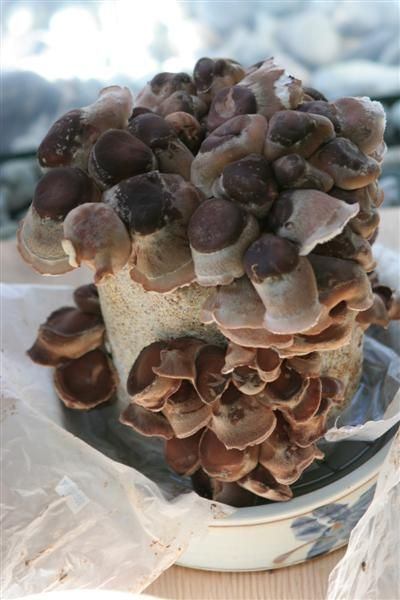
Sawdust will need to be pasteurized. Many mycelium producers cultivate mushroom cultures specifically on sawdust.
Alternative Mushroom Substrates
In addition to straw, logs, and sawdust, there are other effective substrates:
- Compost
- Recycled paper (if newspapers are used, ensure the ink is non-toxic—mushrooms will digest everything)
- Unpainted cardboard
- Used coffee grounds
- Used tea leaves
- Compost and garden waste
- Seed husks, corn cobs, banana leaves, and other organic materials.
Best Substrate for Mushrooms
The substrate should match the type of mushroom. If you have purchased mushroom plugs, logs are the way to go. Mycelium is already familiar with wood fibers and will colonize much faster than, for example, straw. Much depends on the mushroom’s preferences: more finicky Shiitake, Maitake, Reishi, Lion’s Mane prefer wood substrates, enriched sawdust, and logs. Oyster mushrooms will grow anywhere.
General recommendations for substrate-mycelium combinations:
Mycelium on Sawdust - logs, chips, enriched sawdust, cardboard.
Grain Mycelium - straw, sawdust, coffee grounds, compost, organic material.
Mushroom Plugs - stumps, logs, chips.
Mushroom cultivation can be quite inexpensive if you have access to a lot of cardboard, and used coffee grounds can be collected for free from a barista at a nearby café—they will be happy to give it away))).
